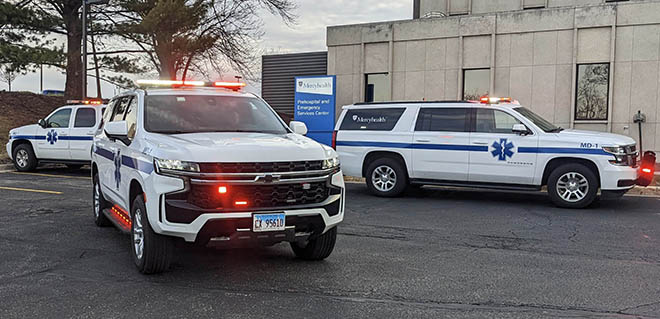Mercyhealth MD 1 unit can help save lives; Mobile ‘ER’ travels to treat patients at the scene

MERCYHEALTH PHOTO Belvidere Republican
Mercyhealth’s MD 1 program brings emergency physicians and ER equipment to the field, such as the site of a natural disaster, crash or someone’s home, to improve patient outcomes when critical minutes count, prior to transport by ambulance to a hospital. The program has four Chevy vehicles loaded with ER-level equipment and eight Mercyhealth EMS physicians in Wisconsin and Illinois with advanced training, including Dr. Matt Smetana, EMS medical director.
While emergency medical response teams such as paramedics are highly trained to address emergencies—resulting from crashes, natural disasters, heart attacks, strokes and catastrophic events—often there is a need for more immediate, advanced medical support at the scene. That is where physicians like Dr. Matt Smetana come in.
The Mercyhealth emergency medicine physician and EMS medical director is one of eight emergency physicians who make up the MD 1 (Medical Director) program in Wisconsin and Illinois—essentially a mobile ER on wheels that can be dispatched upon request to a scene to help stabilize a patient prior to transport to a hospital.
As Dr. Smetana explained it, larger cities around the country have started organizing mobile ERs that bring a physician to a scene. However, he noted, “It’s interesting; the Europeans have been doing this for decades and decades.”
The initiative began in Wisconsin in 2013 and came to northern Illinois in 2015, when Smetana got on board.
While there are urban and suburban areas MD 1 covers, there are also a lot of rural communities dotting the landscape, the doctor said, so “We’re kind of unique,” adding that MD 1 has traveled as far as an hour-and-a-half away to treat patients, serving northwest Illinois.
Any one (or more) of three Chevy Tahoes and one Chevy Suburban—equipped with lights, sirens and radio networks—will travel with the same kind of equipment found in an emergency room, he continued, describing that “We try to have things we need to take care of a critical patient.”
The vehicles have intubation equipment, chest tubes, point-of-care ultrasound, medications, extrication tools, field amputation tools and more according to the Mercyhealth website.
Smetana said the idea is “to bring hospital-level care” to a scene—whether it be a crash or natural disaster site, or even someone’s home.
“All of the doctors have additional training beyond what it takes to be an ER doctor,” he pointed out, mentioning that he, himself, was formerly a firefighter/paramedic before becoming a doctor.
Smetana emphasized that when he is called to a scene, he does not automatically take over unless asked to do so, but instead, “We always operate within the chain of command,” typically being the first responders on a scene.
The doctor further described how, when he or another physician is dispatched—always at the request of an emergency provider—he and the first responders “take an organized approach to triage … to do the most good for the most number of patients.”
“My job is to elevate their [first responders] skills when working together, in a collaborative approach,” he reiterated, because the bottom line for him is about “what we can do in the field to improve the chance of a better outcome.”
“It is very different in the field versus the emergency department,” Dr. Smetana commented. “By the nature of our job, we respond to a lot of mass casualty events … multiple critically ill patients with significant injuries.”
Dr. Smetana gave as an example being called to respond to a tornado last year that left at least one person dead and over 40 others injured when the roof collapsed at the Apollo Theatre in Belvidere.
He remembers that another ER physician, from Wisconsin, was called to the scene, adding, “I was very proud of the work we did. It’s all about teamwork.”
“Boone County,” he continued, “has phenomenal first responders.”
The doctor said he does not transport patients to a hospital, but treats them in a variety of scenarios, such as on-scene. However, he might meet an ambulance on the highway or road, and “I’m doing it [providing medical care] at highway speeds.”
“Traveling at 60 miles an hour, traveling down the highway, it is a team activity,” Smetana said. “We can improve the chance of a positive outcome for the patient.”
Talk to Smetana for even a minute and it is clear he is passionate about the work he does, in part because “I like to meet them [patients] before the worst scenarios,” when they arrive at the hospital. After all, he believes, “It’s the worst day of their lives.”
The doctor said he also works to educate first responders, to enhance their knowledge. In Illinois alone, the doctor oversees more than 40 EMS agencies—with roughly 900 licensed EMS providers—and related that his goal is “educating and teaching” these first responders about medical intervention in the field, to improve patient outcomes.
And, Smetana noted, MD 1 is provided at no charge to the patient, because “Mercyhealth considers us a community service.”
As for the ER physician, he summed up his role with MD 1 as “an absolute blessing to do what we get to do.”
Visit mercyhealth.org for more information.



